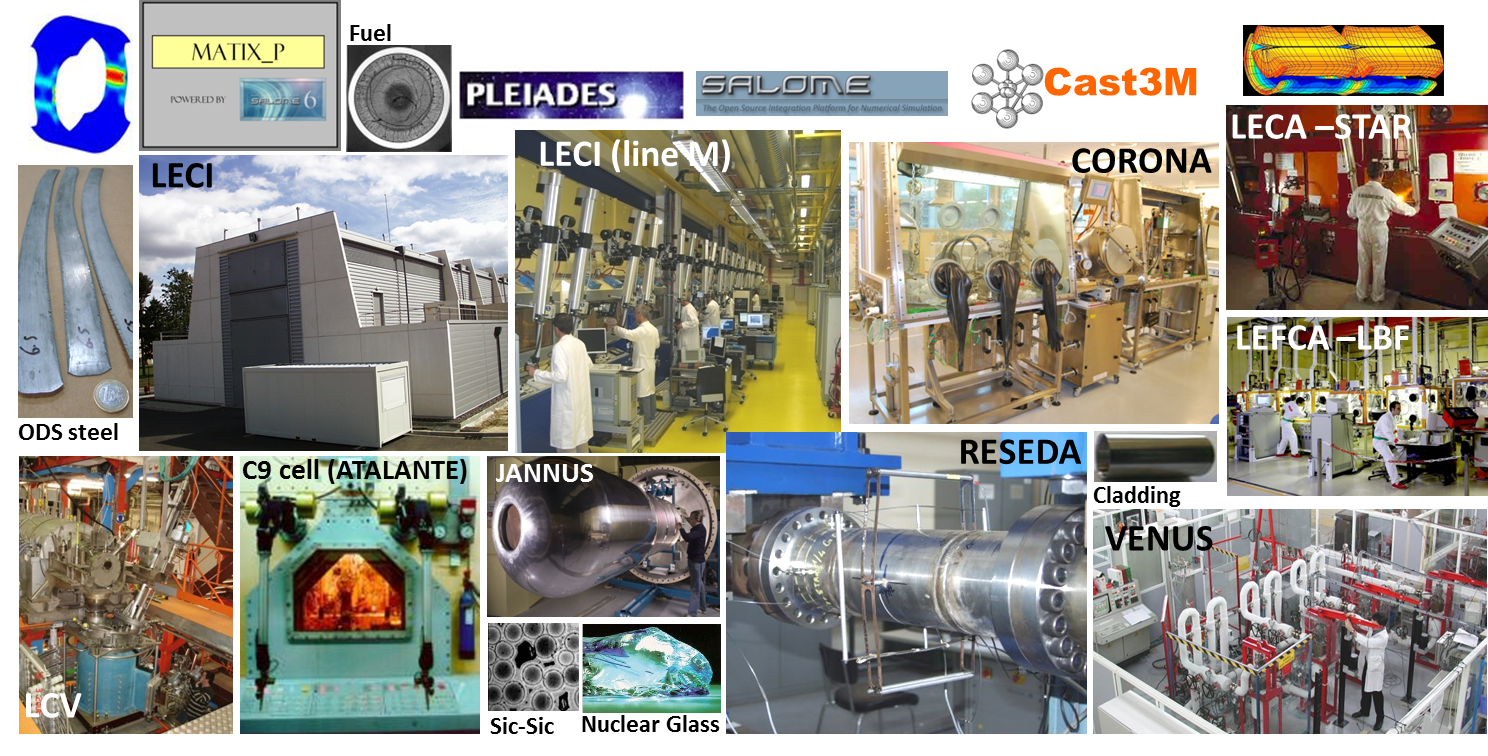Introduction and background
By gathering the expertise means of the DEN Division on nuclear materials, MINOS covers a broad spectrum of R&D activities in the field of materials science dedicated to nuclear applications (reactors, waste management).
Complex systems for nuclear-based electricity may be exposed to severe service conditions (irradiation, temperature, mechanical loading, corrosive environments). It is thus essential to rely on high-performance and durable materials and structures. In order to extend the service life of current reactors and to improve NPP availability, research must be performed to guarantee that they can be done safely. Optimizing current and future claddings and fuels, and designing new materials for 4th generation reactors call for innovative breakthroughs to increase the reliability of predictive models for nominal operating conditions and potential accident scenarios. Numerous research programs are also carried out in the framework of waste management to develop optimized and durable conditioning matrices.
MINOS sustains strategic research partnerships and innovative research programs related to material and structure behavior in severe environments. The centre is committed to a partnership with the National Institute for Nuclear Science & Technology (INSTN), to promote and develop training and educational activities in materials science. With MINOS, CEA reaffirms its position as a world leader in nuclear materials R&D and demonstrates a strong innovative capacity and ability to execute and supervise research programs for industrial partners.
Main partners:
- Industrial: EDF, MAI, AREVA, GDF SUEZ, ANDRA, EPRI, CGNPC, JAEA, KAERI, MNF, STUDSVIK;
- Academic: Ecole Polytechnique, Mines Paris-Tech, ECP, ECM, ENSAM, ENS, ENSC, ICB, INPG, CIRIMAT, EMSE;
- Research organizations: CNRS, IGCAR-BARC, CEREGE, SCK-CEN, VTT, ITU, KIT, DOE, IRSN, GANIL, ROSATOM, RIAR, IPPE;
- International organizations: AIEA, OECD/NEA, EURATOM, EFDA, GIF (GEN IV);
- Research networks: ANCRE, EERA, EMIR, NUGENIA, ACTINET, GEDEPEON, GENESIS;
- International research facilities: SOLEIL, ESRF, INE, GANIL.
- JANNuS triple beam irradiation platform, LECI hot lab facility, Nanomakers;
- Irradiated fuel characterization protocols, gas fission products analyses, fuel manufacturing processes, fuel rods examination, fuel multi-scale modeling (PLEIADES numerical platform), fuel design;
- SCC crack propagation mechanism, H2 material embrittlement, tritium laboratory, sodium material interactions;
- JANNuS triple beam irradiation platform, LECI hot lab facility, Nanomakers;
- CAST3M FEM software, SALOME (numerical simulation integrated platform), RESEDA experimental platform;
- LCV Joint Vitrification Laboratory;
- Manufacturing process of minor actinides (Am, Np, cm) bearing oxide fuels, manufacturing and characterization of these fuels for irradiation experiments in reactor (FUTURIX and MARIOS experiments).
Participation to national, European and international projects:
- EURATOM projects: PERFORM_60, GETMAT, LONGLIFE, F-BRIDGE, CARBOWASTE, PELGRIM, DOMOPLEX, FAIRFUELS, CP-ESFR, NFIR, SCIP, CIP, MatISSE;
- ANR projects: Defi H12, H-Synthex, NANOTICAL, CoIrrHeSim, SYZHYP;
- GIF systems and projects: SFR, GFR, VHTR;
- NEEDS projects.
MINOS, key figures
6 operational departments involved
720 staff members, including 430 scientists and 220 technicians
100 PhD and 30 post-graduate students
600 internal reports, 200 publications and 300 communications per year
30 patents per year
Sofware programs, codes & multi-scale simulation platforms: CAST3M, EUROPLEXUS, RCC-MRx, SALOME, MATIX_P, PLEIADES, GRAAL
Main experimental platforms: RESEDA, ALTEA, CORROSION
Main hot facilities: LECI, LECA-STAR, LEFCA-LBF, LCV, LEMA (in ATALANTE)
Main irradiation platforms: JANNuS, high voltage TEM and easy access to OSIRIS experimental reactor ant to JHR in the future
Contribution to 40 European and international projects and 15 ANR national projects

MINOS major (or associated with) experimental and simulation platforms and hot facilities


